Advertisements
Advertisements
Question
A charge of 1 µC is given to one plate of a parallel-plate capacitor of capacitance 0⋅1 µF and a charge of 2 µC is given to the other plate. Find the potential difference developed between the plates.
Solution
Charges on the plates :
`q_1 = 1 "uC" = 1 xx 10^-6 C`
`q_2 = 2 "uC" = 2 xx 10^-6 C`
The effective charge on the capacitor is given by `q_"net" = (q_2 - q_1)/2` = `((2-1) xx 10^-6)/2` = `0.5 xx 10^-6 "C"`
The potential difference is given by `V = q_"net"/C = (0.5 xx 10^-6)/(0.1 xx 10^-6) = 5V`
APPEARS IN
RELATED QUESTIONS
Distinguish between Conductors and Insulators.
Draw a labelled diagram of Van de Graaff generator. State its working principle to show how by introducing a small charged sphere into a larger sphere, a large amount of charge can be transferred to the outer sphere. State the use of this machine and also point out its limitations.
The potential difference applied across a given resistor is altered so that the heat produced per second increases by a factor of 9. By what factor does the applied potential difference change?
A metal rod of square cross-sectional area A having length l has current I flowing through it when a potential difference of V volt is applied across its ends (figure I). Now the rod is cut parallel to its length into two identical pieces and joined as shown in figure II. What potential difference must be maintained across the length of 2l. so that the current in the rod is still I?

Explain the principle of a device that can build up high voltages of the order of a few million volts.
Draw a schematic diagram and explain the working of Van de Graff generator device.
Is there any restriction on the upper limit of the high voltage set up in Van de Graff generator machine? Explain.
A 100 pF capacitor is charged to a potential difference of 24 V. It is connected to an uncharged capacitor of capacitance 20 pF. What will be the new potential difference across the 100 pF capacitor?
Find the potential difference `V_a - V_b` between the points a and b shown in each part of the figure.
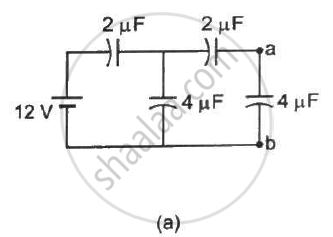
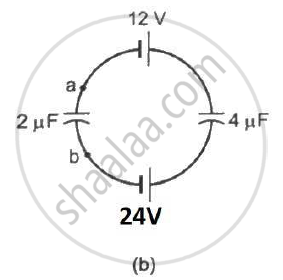
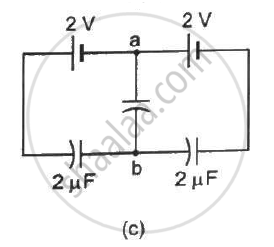
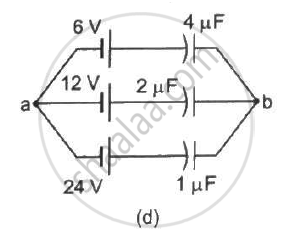
A charge of `+2.0 xx 10^-8 C` is placed on the positive plate and a charge of `-1.0 xx 10^-8 C` on the negative plate of a parallel-plate capacitor of capacitance `1.2 xx 10^-3 "uF"` . Calculate the potential difference developed between the plates.
The capacitance between the adjacent plates shown in figure is 50 nF. A charge of 1⋅0 µC is placed on the middle plate. (a) What will be the charge on the outer surface of the upper plate? (b) Find the potential difference developed between the upper and the middle plates.
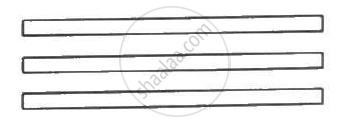
The capacitance between the adjacent plates shown in the figure is 50 nF. A charge of 1.0µC is placed on the middle plate. If 1.0 µC is placed on the upper plate instead of the middle, what will be the potential difference between (a) the upper and the middle plates and (b) the middle and the lower plates?
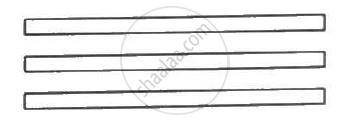
Two capacitors of capacitance 20⋅0 pF and 50⋅0 pF are connected in series with a 6⋅00 V battery. Find (a) the potential difference across each capacitor and (b) the energy stored in each capacitor.
A capacitor having a capacitance of 100 µF is charged to a potential difference of 50 V. (a) What is the magnitude of the charge on each plate? (b) The charging battery is disconnected and a dielectric of dielectric constant 2⋅5 is inserted. Calculate the new potential difference between the plates. (c) What charge would have produced this potential difference in absence of the dielectric slab. (d) Find the charge induced at a surface of the dielectric slab.
What will be the potential difference in the circuit when direct current is passed through the circuit?
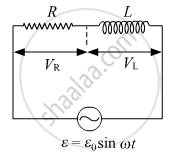
Two metal pieces having a potential difference of 800 V are 0.02 m apart horizontally. A particle of mass 1.96 × 10–15 kg is suspended in equilibrium between the plates. If e is the elementary charge, then charge on the particle is ______.
Assertion: Electric potential and electric potential energy are different quantities.
Reason: For a system of positive test charge and point charge electric potential energy = electric potential.
A and B are two points in an electric field. If the work done in carrying 4.0C of electric charge from A to B is 16.0 J, the potential difference between A and B is:
Can there be a potential difference between two adjacent conductors carrying the same charge?
